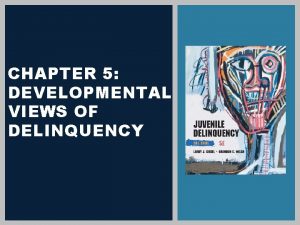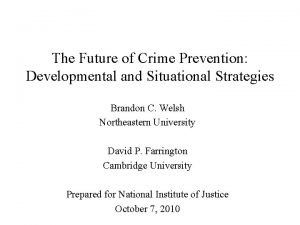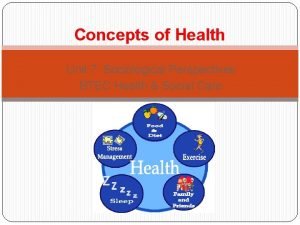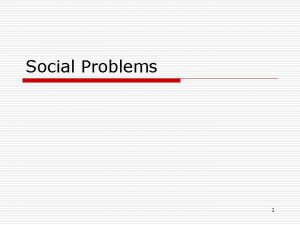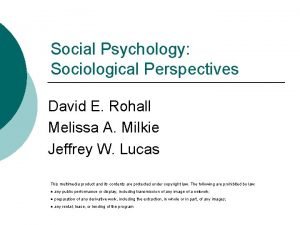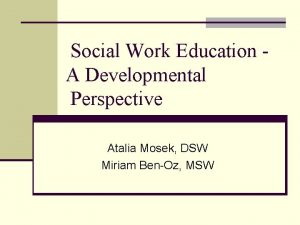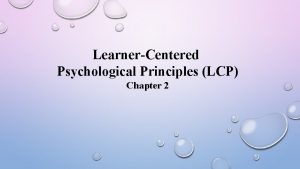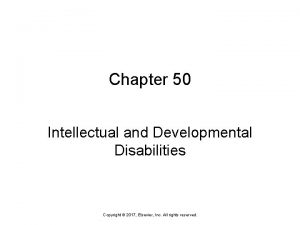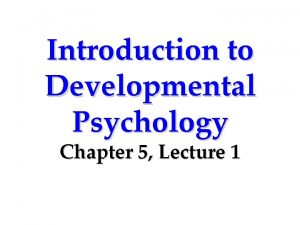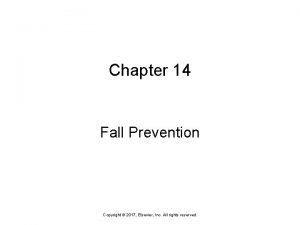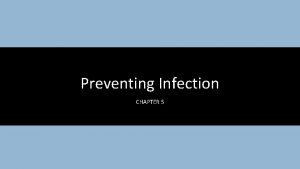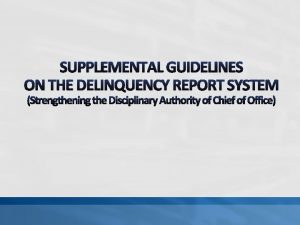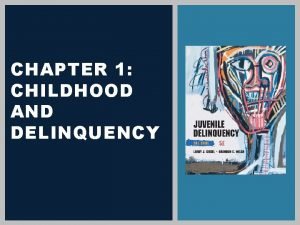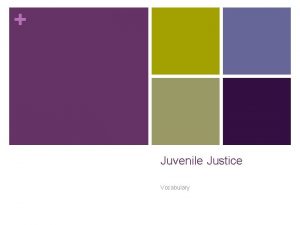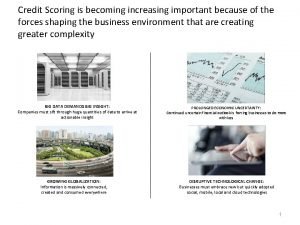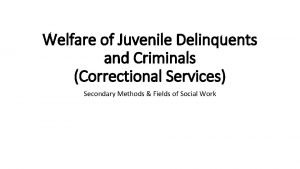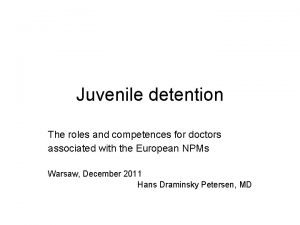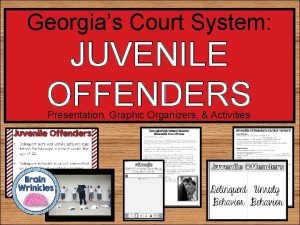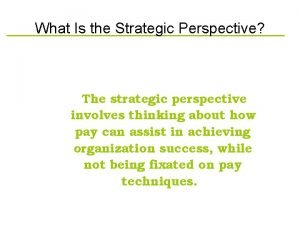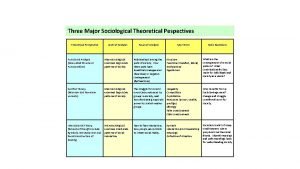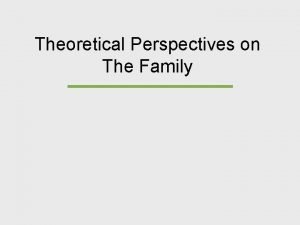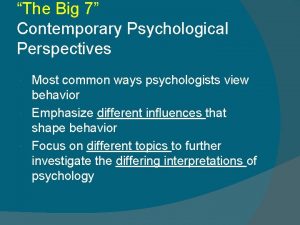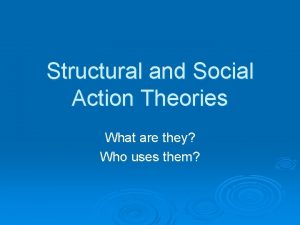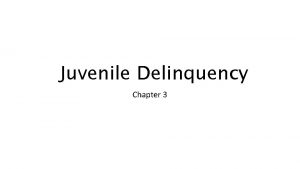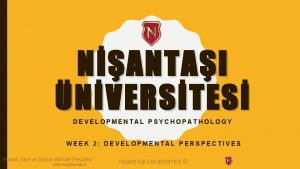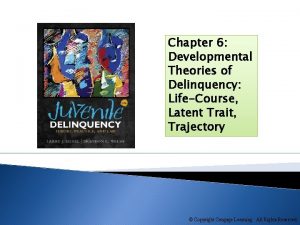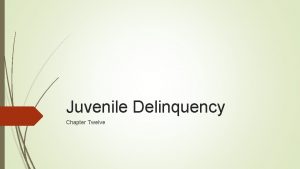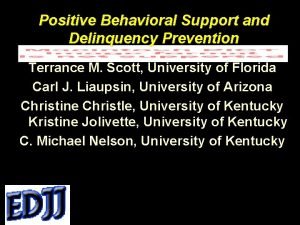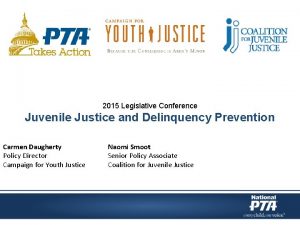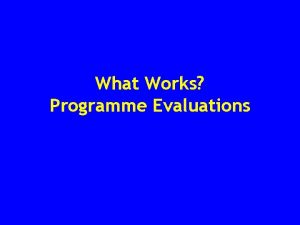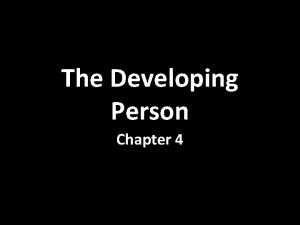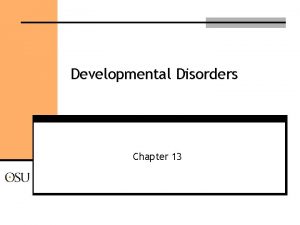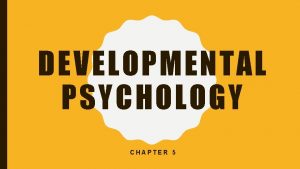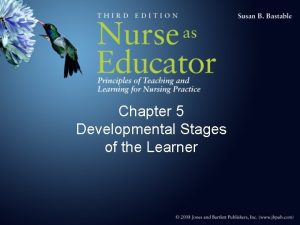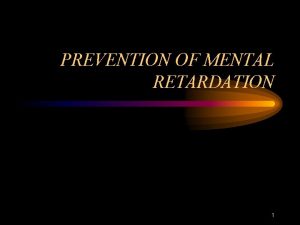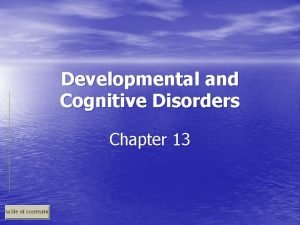Delinquency Prevention Social Chapter 12 Developmental Perspectives Delinquency















































- Slides: 47

Delinquency Prevention: Social & Chapter 12 Developmental Perspectives

Delinquency Prevention vs. Delinquency Control/Delinquency Repression Involves any justice program or policy designed to prevent the occurrence of a future delinquent act. Delinquency Prevention Involves any non-justice program or policy designed to prevent the occurrence of a future delinquent act. Refers to intervening in young people’s lives before they engage in delinquency in the first place. Siegel & Welsh, 2014

Prevention vs. Control Siegel & Welsh, 2014

The Many Faces of Delinquency Prevention Costs of Delinquency: A Justification for Prevention There is no doubt that crime costs everyone in society State costs - the costs of violent offenses by juveniles in Pennsylvania was $2. 6 billion in victim costs and $46 billion in perpetrator costs per year Perpetrator costs like probation, detention, juvenile treatment programs, and incarceration Victims the main reason for the cost difference is juveniles suffer more sexual abuse Siegel & Welsh, 2014

The Many Faces of Delinquency Prevention National costs Homicide and assault related injuries perpetrated by juveniles sot the U. S. $16 billion each year Which includes federal, state, and local governments to assist victims of juvenile violence like medical treatment Pain and suffering is not accounted in this estimate or societal response costs Siegel & Welsh, 2014

Brief History of Delinquency Prevention Chicago Area Project- earliest JV delinquency prevention projects in 1933 by Shaw and Mc. Kay Designed to produce social change in communities that suffered from high delinquency and gang activity Local leaders coordinated social service centers that promoted community solidarity and counteract social disorganization Shaw and Mc. Kay’s commitment to creating community consciousness directing at solving social problems on the local level Siegel & Welsh, 2014

The Chicago Areas Project (CAPS) • Three basic goals: Provide a forum for local residents to become acquainted with new scientific perspectives. Initiate new channels of communication between local residents and institutional representatives of the larger community. Bring adults into contact with local youths. Siegel & Welsh, 2014

Chicago Area Project 20 different programs were developed like discussion groups, counseling services, hobby groups, school-related activities, & recreation Unfortunately some evals of program showed positive results while others revealed the project did little to reduce juvenile delinquency Siegel & Welsh, 2014

Brief History of Delinquency Prevention Cambridge-Somerville Youth Study same time frame as CAPS Focus of program was on improving individuals than their surroundings First delinquency program to be evaluated using a randomized experimental design. 650 boys broken into 2 groups of 325 received the program – experimental group and 325 did not – the control group Siegel & Welsh, 2014

Cambridge-Somerville Youth Study Control group received attention from counselors for 5 years, as well as medical and educational services. Included taking youth on trips, visiting the families for support and so on Program continued for 10 years, however WWII occurred and most adult counselors were drafted Program was evaluated 45 years later and found those in experimental group committed more crimes than those in control group. Stated that this was probably due to program being done in groups instead of one on one thereby some being influenced by other more serious delinquents Siegel & Welsh, 2014

History of delinquency prevention Detached street workers programs - 1950 s Having social workers go to inner city neighborhoods and create close relationships with juvenile gangs and groups on their turf. Best know is Mid-City Project Workers tried to get youth jobs and educational opportunities Acted as go-betweens for gang members and with lawyers, judges, parole officers, & so on. Siegel & Welsh, 2014

The Many Faces of Delinquency Prevention Classifying Delinquency Prevention Public health approach- to prevent disease & injuries and broke it down into 3 categories: Primary prevention -general well-being of individual through access to health care, prevention education, & modifying conditions of environment that are conducive to delinquency Secondary prevention – intervening children who are at risk and provisions of neighborhood programs to deter delinquent activity Tertiary prevention – intervention with adjudicated youth with substance abuse treatment & imprisonment. Goal was reducing recidivism Siegel & Welsh, 2014

The Many Faces of Delinquency Prevention Developmental perspective Refers to interventions specifically targeting risk/protective factors Risk factor – a negative prior factor in an individual’s life that increases the risk of occurrence of a future delinquent act. Protective factor – a positive prior factor in an individual’s life the decreases the risk of occurrence of a future delinquent act.

Concept Summary 12. 1 Siegel & Welsh, 2014

Early Prevention of Delinquency

Early prevention Early childhood delinquency prevention programs that have been implemented in 4 influential settings: Home, daycare, preschool, and school Home-based programs- to prevent delinquency involves provision of support for families in their homes. Like home visitation. Siegel & Welsh, 2014

Home Visitation Best known are Nurse-Family Partnership that was started in Elmira, NY. Had 3 broad approaches: improve the outcomes of pregnancy Improve quality of care that parents provide to their children and their health care development Improve women’s own personal life-course development with helping them complete their education, finding employment, and planning future pregnancies.

Home Visitation Program targets young 1 st time mothers, unmarried, and poor. In all about 400 women were enrolled Home visits lasted 1 or more & occurred every two weeks Advice was given to mothers about child care, infant development, & nutrition After 15 years, evaluations of control group & program participators Participators had fewer convictions & violations of probation

Home Visitation less likely to runaway from home Less likely to rink alcohol Program also successful in preventing delinquent crime & delinquent activities Lowered rates of child abuse & neglect Lowered substance abuse Lowered reliance on welfare and social services

figure 12. 1 Costs and Benefits of Home Visits for High-Risk Families Siegel & Welsh, 2014

Early prevention Improving Parenting Skills – has showed some success Family based prevention to improve core parenting skills Oregon Social Learning Center – most widely cited program Research had Gerald Patterson convinced that poor parenting skills were associated with antisocial behavior in the home and school Parents not knowing how to effectively deal with their children like inconsistent consequences for behavior. Taught parents behavior modification Turned out to be the most cost effective method of early intervention Siegel & Welsh, 2014

Oregon Social Learning Center, cont 501 serious crimes could be prevented for every million $ spent on parenting skills (or $2, 000 per crime), a far cheaper solution than long term incarceration Positive outcomes in a number of areas Educational success Delinquency Cognitive development Involvement in the justice system Family well-being

Early prevention Daycare Programs Allowed parents to go back to work and kids a chance to socialize & stimulate skills 2 programs in particular worth mentioning for positive early intervention Syracuse University Family Development Research Program Houston Parent-Child Development Center High quality daycares Positive outcomes Lower juvenile court referrals, more likely to express positive feelings about themselves, able to take a more active role in dealing with personal problems Siegel & Welsh, 2014

Early prevention School Programs in the Primary Grades Preschool is important because this is a formative time for brain development Highly structured, cognitive-based preschool programs Developmentally appropriate learning curricula Wide array of cognitive-based enriching activities Activities for parents so that they may be able to support the school experience at home. Siegel & Welsh, 2014

Early prevention Preschool Head Start Centers are in a variety of states Positive outcomes Fewer lifetime arrests, higher levels of high school completion, higher earnings Siegel & Welsh, 2014

Early prevention School Programs in primary grades worth mentioning: Seattle Social Development Project Montreal Longitudinal-Experimental Study Good Behavior Game Positive outcomes More commitment and attachment to school, better academic achievement, fewer delinquent acts, fewer instances of selling drugs, less likely to have a court charge

Siegel & Welsh, 2014

Prevention of Delinquency in the teenage years

Prevention – teenage years Mentoring - nonprofessional volunteers spending time with at-risk youth Federal mentoring programs -OJJDP has supported mentoring and mainly through JUMP – Juvenile mentoring program and no called Mentoring Initiative for System Involved Youth (MISIY) Provides funding to faith based and community based agencies to mentor youth involved in the CJS system, foster care, and reentry programs Siegel & Welsh, 2014

Prevention – teenage years Mentors, cont. Mentors work one to one with youth Significant reductions in: aggressive behavior/delinquency, peer relationships, and mental health Effectiveness of mentoring Positive effects on delinquency, academic achievement, drug use, and aggression

Prevention – teenage years Mentoring, cont. Why do some mentoring programs work and not others? Mentors are a source of support and guidance to help young people deal with a broad range of issues related to family, school, and future career. They work one-on-one with young people. Care is taken in matching the mentor and young person. Mentors display empathy, pay particular attention to and nurture the strengths of the young person, and treat them “as a person of equal worth and value. ” Siegel & Welsh, 2014

Prevention – teenage years School Programs for Teens Key features of successful school-based delinquency prevention programs: Focus on reducing school disorders Improving the school environment Improving family environment Reducing negative peer influences Project PATHE –comprehensive program used in secondary schools that reduces school disorder & aims to improvement school environments. Enhance school experience & attitudes about school to increase bonds which will enhance self-esteem, educational, and occupational attainment. Which can reduce delinquency. Siegel & Welsh, 2014

Prevention – teenage years Violence prevention curriculum for adolescents Instructional based violence prevention Done in 10 sessions Interactive with teacher and students with brain storming and role-playing Evaluation: showed fighting had significantly reduced among those teens who attended when compared to a control group of teens who did not Siegel & Welsh, 2014

Prevention – teenage years After-School Program Recreation, tutoring programs, dance groups, drop-in clubs Reduced damage, delinquency, substance abuse, drug trafficking, and other drug-related delinquent activity Reduced delinquency Need for further evaluation Siegel & Welsh, 2014

Prevention – teenage years After-School Program Boys and girls clubs of America founded in 1902, non-for-profit organization Today membership is 1. 3 million youth 6 main areas: cultural enrichment, health/physical education, social recreation, personal/education development, citizenship/leadership development, and environmental education Participate and Learn Skills – Canadian program in public housing development in Ottawa. Recruited young people from these areas to participate in sport activities like hockey, music, dance, scouting and so on. Siegel & Welsh, 2014

Prevention – teenage years Job Training Job Corps- 1964– federal training program, helping kids prepare for adult workforce Job training programs for youth 16 -24 years old Reductions in criminal activity, improvements in educational attainment, and greater earnings. Siegel & Welsh, 2014

Prevention – teenage years Job Training Youth Build U. S. A. – 1978 – for youth ages 16 -24 Focus on building or renovating affordable housing. Have build 21, 000 units since 1994. Youth learn skills in carpentry and construction Reductions in offending and improvements in educational attainment Saving money overall because less teens in the system Siegel & Welsh, 2014

Prevention – teenage years Comprehensive Community-Based Programs – tailoring programs and needs that meet local conditions CASASTART – Centers on Addiction & Substance Abuse’s Striving Together to Achieve Rewarding Tomorrows. Delivered to a large number of young people in poor and high-crime neighborhoods Usual preventative aids like family counseling, tutoring, afterschool activities, mentoring, and community policing. Lower violent delinquency, drug use and sales Communities that Care (CTC)- is another one Siegel & Welsh, 2014

Media Tool “Community Based Delinquency Prevention Programs” http: //www. ojp. usdoj. gov/Res. Guide/commun. h tm Discussion: What do you think of these programs? Do you believe that they are effective? Why or why not? Siegel & Welsh, 2014

Future of Delinquency Prevention

Future of Delinquency Prevention Obstacles for Future Programs Ethical concerns about early intervention Labeling and stigmatization associated with programs that target high-risk populations Effects of evidence-based delinquency prevention programs can attenuate or diminish when scaled up for wider public use. Long delay before early childhood programs can have an impact on delinquency. Siegel & Welsh, 2014

Future of Delinquency Prevention The future depends on the education of the public and key decision makers about the value of preventing delinquency The costs of running prevention programs are low relative to the costly nature of delinquency Proving its worth Siegel & Welsh, 2014

Project Human Development in Chicago

The Project on Human Development in Chicago Neighborhoods v Another research project in Chicago v Interdisciplinary study of how families, schools, and neighborhoods, affect child and adolescent development Longitudinal Study of interviews with more than 6000 youth and their caregivers, along with a neighborhood survey of more than 9000 residents Siegel & Welsh, 2014

The Project on Human Development in Chicago Neighborhoods Early Findings • Collective efficacy: Shared values, trust, and expectations for social interventions The levels of collective efficacy are strongly influenced by neighborhood conditions. Neighborhoods with more collective efficacy tend to have lower crime and deviance rates. Collective efficacy seems to be the mediating link. Siegel & Welsh, 2014

Clip on Human Development of Chicago Neighborhoods Project

 Primary prevention secondary prevention tertiary prevention
Primary prevention secondary prevention tertiary prevention Developmental theory juvenile delinquency
Developmental theory juvenile delinquency Developmental crime prevention
Developmental crime prevention Unit 7 health and social care
Unit 7 health and social care Importance of textbook
Importance of textbook The social and ethical perspectives of entrepreneurship
The social and ethical perspectives of entrepreneurship Social psychology sociological perspectives
Social psychology sociological perspectives Developmental perspective social work
Developmental perspective social work 6 principles of cognitive and metacognitive factors
6 principles of cognitive and metacognitive factors Nature and extent of juvenile delinquency
Nature and extent of juvenile delinquency Nelson science perspectives 9 chapter 12
Nelson science perspectives 9 chapter 12 Chapter 50 intellectual and developmental disabilities
Chapter 50 intellectual and developmental disabilities Chapter 11 developmental theories
Chapter 11 developmental theories Chapter 5 developmental psychology
Chapter 5 developmental psychology Social thinking and social influence
Social thinking and social influence Social thinking social influence social relations
Social thinking social influence social relations Glencoe health chapter 5 review answers
Glencoe health chapter 5 review answers Puncture resistant container
Puncture resistant container Chapter 26 infectious disease prevention and control
Chapter 26 infectious disease prevention and control Chapter 19 disease transmission and infection prevention
Chapter 19 disease transmission and infection prevention Chapter 19 disease transmission and infection prevention
Chapter 19 disease transmission and infection prevention Chapter 14 fall prevention
Chapter 14 fall prevention Chapter 16 infection prevention and control
Chapter 16 infection prevention and control Define infection prevention chapter 5
Define infection prevention chapter 5 Delinquency report pnp sample
Delinquency report pnp sample Delinquency management in microfinance
Delinquency management in microfinance According to choice theorists, offenders
According to choice theorists, offenders Objectives of studying juvenile delinquency
Objectives of studying juvenile delinquency What is paydex
What is paydex Poverty and juvenile delinquency
Poverty and juvenile delinquency Cottage reformatories
Cottage reformatories Newspaper article on juvenile delinquency
Newspaper article on juvenile delinquency Female delinquency theories
Female delinquency theories What is a good delinquency predictor score
What is a good delinquency predictor score Categories of delinquent youth
Categories of delinquent youth Treatment of juvenile delinquency
Treatment of juvenile delinquency Delinquency management system
Delinquency management system Management of juvenile delinquency
Management of juvenile delinquency Juvenile offenders comprehension check answers
Juvenile offenders comprehension check answers Perspectives on appeasement interactive notebook
Perspectives on appeasement interactive notebook Strategic perspective meaning
Strategic perspective meaning Debts or money owed
Debts or money owed Three theoretical perspectives in sociology
Three theoretical perspectives in sociology Theoretical perspectives on the family
Theoretical perspectives on the family Four theoretical perspectives
Four theoretical perspectives Kw 6 personal perspectives
Kw 6 personal perspectives 7 perspectives of psychology
7 perspectives of psychology Differences between structural and action perspectives
Differences between structural and action perspectives

